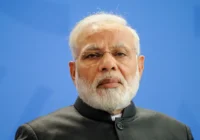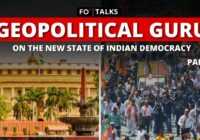In the recent Indian elections, the Bharatiya Janata Party (BJP) won 240 seats out of 543 in India’s lower house of parliament, the Lok Sabha. This left the BJP 33 short of a majority to form the government on its own. Yet all is not lost for the BJP because the party is part of the National Democratic Alliance (NDA) comprising smaller regional parties. Together, the NDA has secured 293 seats. On June 5, the NDA reaffirmed incumbent Indian Prime Minister Narendra Modi as its leader. So, Modi will stay on as prime minister.
The results are a bitter disappointment for Modi. He had been aiming for 400 seats in these elections. Still, Modi continues to be the most powerful leader in India. He campaigned across the length and breadth of the country, drawing big crowds. Millions voted for the BJP because of Modi and continue to support the party because of him. This is the first data point that much of the media seems to be ignoring. Note that the Indian National Congress (INC) has come a distant second with 99 seats.
Related Reading
The effectiveness of the safety net is the second valuable data point. The Modi government’s program to distribute five kilograms (11 pounds) of wheat or rice every month to over 800 million people. This has provided food security to the Indian masses. At a time when food inflation is raging across the world, the Modi government has saved millions of poor people from the pressure to earn enough to eat.
The third data point is that alliances saved the day for the BJP. The BJP’s new alliances forged in 2023–2024 helped the party to retain power. The alliances formed with Janata Dal (United) in Bihar, JD (Secular) in Karnataka and Telugu Desam Party (TDP) in Andhra Pradesh have saved the day for the Modi-led BJP. In 2004, the BJP lost power after its “India Shining” campaign bombed at the electoral box office. In 2024, the party avoided that fate.
The fourth data point is the BJP’s continued hold over Central India. The BJP retained its hold on Central India. In Madhya Pradesh, Shivraj Singh Chauhan led the BJP to victory in 29 out of 29 seats. The INC contested 28 seats and lost all of them. In Chhattisgarh, the BJP won 10 out 11 seats. The INC won just one seat in the state. Both states have BJP governments and, if the anti-incumbency factor had taken root, the BJP might have been in trouble.
The fifth data point is that the BJP has succeeded in its strategy of expanding east and broadening the base of the party. The BJP’s huge efforts paid off to win votes in Odisha, where the BJP won 20 seats and the INC won only one. The local Biju Janata Dal drew a blank. It is true that this electoral outreach did not yield big results in West Bengal. Mamata Banerjee’s All India Trinamool Congress won 29 seats; the BJP won 12, and the INC won one. Worryingly for the BJP, it lost six seats and its vote share fell from 40.64% to 38.73%.
The sixth data point is that the BJP has breached the opposition bastion of South India. The BJP made inroads into South India. In Karnataka, the party had lost the recent 2023 state elections. Of the 28 seats, the BJP won 17 seats and its ally JD(S) won two seats. The INC won just nine seats. In Telangana, the BJP won eight seats out of 17. The BJP also won three seats in Andhra Pradesh where it had won none in the last elections in 2024. The BJP also won the seat of Thrissur in Kerala, a historic first.
The seventh data point is that the Modi-led BJP still retains women support. Women voters continued to support Modi. By focusing on menstrual hygiene, toilets, piped water to homes and gas cylinders, the prime minister has won over women. Solid women support helped the BJP counter the youth disaffection arising from lack of jobs.
The eighth data point for the BJP is that a strong national security policy helped the BJP. Indians see the INC-led government from 2004 to 2014 as soft on Pakistan. Indians continue to trust Modi and the BJP with national security more than INC and its leader Rahul Gandhi.
The ninth data point for the BJP is fulfilling promises on core issues. The Modi-led government abrogated Article 370, which gave special status to the state of Jammu and Kashmir. This year, Modi also inaugurated the Ram temple in Ayodhya. This pleased many core BJP voters. Article 270 and the Ram temple are core issues for the BJP’s parent organization, the Rashtriya Swayamsevak Sangh (RSS), In 2004, many RSS workers and BJP supporters were disappointed, leading to the fall of the BJP-led Modi government.
The tenth and final data point for the BJP is that voters have rewarded the Modi administration for providing a relatively clean and competent national government. Before 2014, Indian voters always put corruption among the top three national issues. In fact, a national anti-corruption movement rocked the INC-led government in 2011 and decimated its public support. In contrast, Modi has won a third term like Jawaharlal Nehru, India’s first prime minister, and made history.
The views expressed in this article are the author’s own and do not necessarily reflect Fair Observer’s editorial policy.
Support Fair Observer
We rely on your support for our independence, diversity and quality.
For more than 10 years, Fair Observer has been free, fair and independent. No billionaire owns us, no advertisers control us. We are a reader-supported nonprofit. Unlike many other publications, we keep our content free for readers regardless of where they live or whether they can afford to pay. We have no paywalls and no ads.
In the post-truth era of fake news, echo chambers and filter bubbles, we publish a plurality of perspectives from around the world. Anyone can publish with us, but everyone goes through a rigorous editorial process. So, you get fact-checked, well-reasoned content instead of noise.
We publish 2,500+ voices from 90+ countries. We also conduct education and training programs
on subjects ranging from digital media and journalism to writing and critical thinking. This
doesn’t come cheap. Servers, editors, trainers and web developers cost
money.
Please consider supporting us on a regular basis as a recurring donor or a
sustaining member.
Will you support FO’s journalism?
We rely on your support for our independence, diversity and quality.








Comment